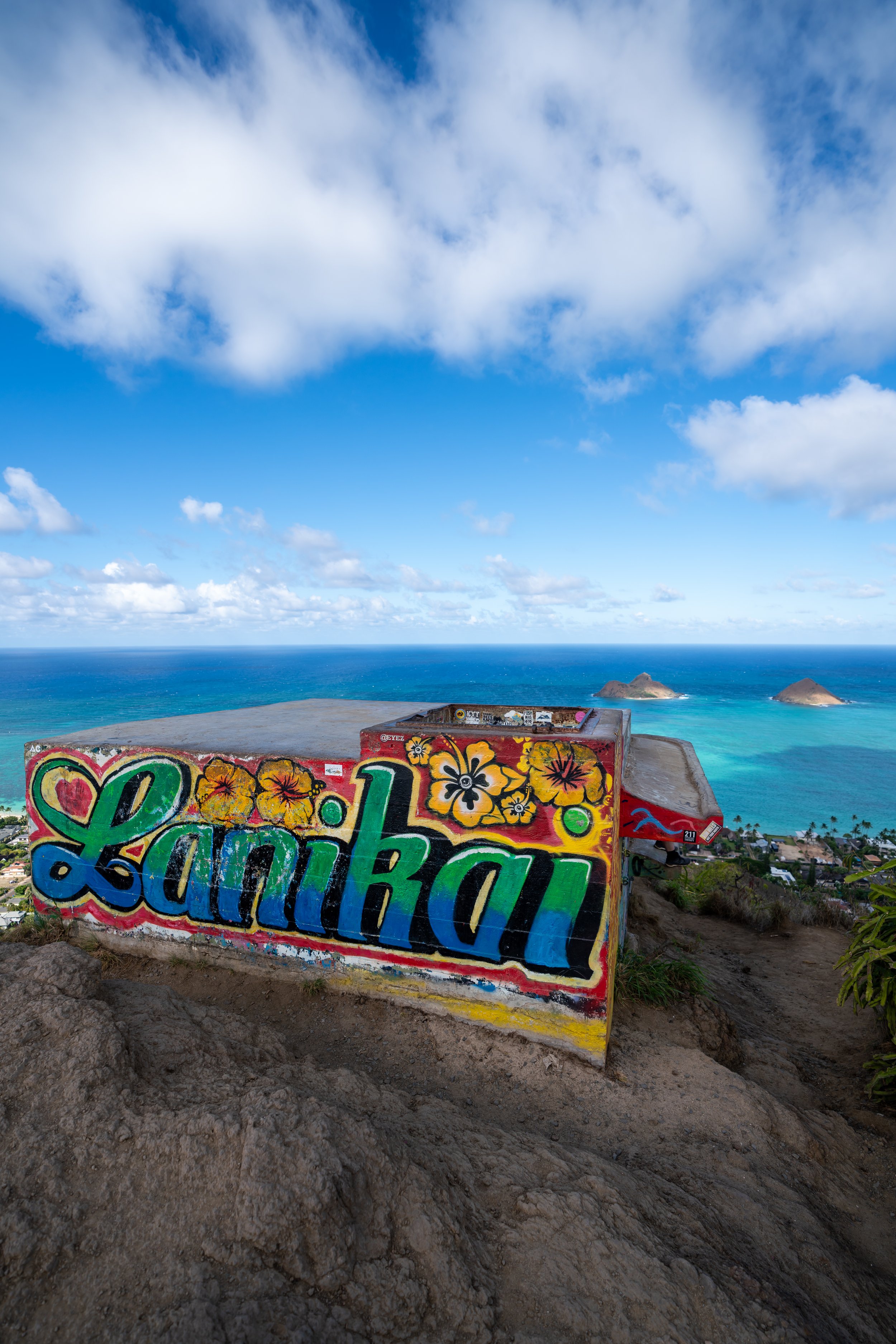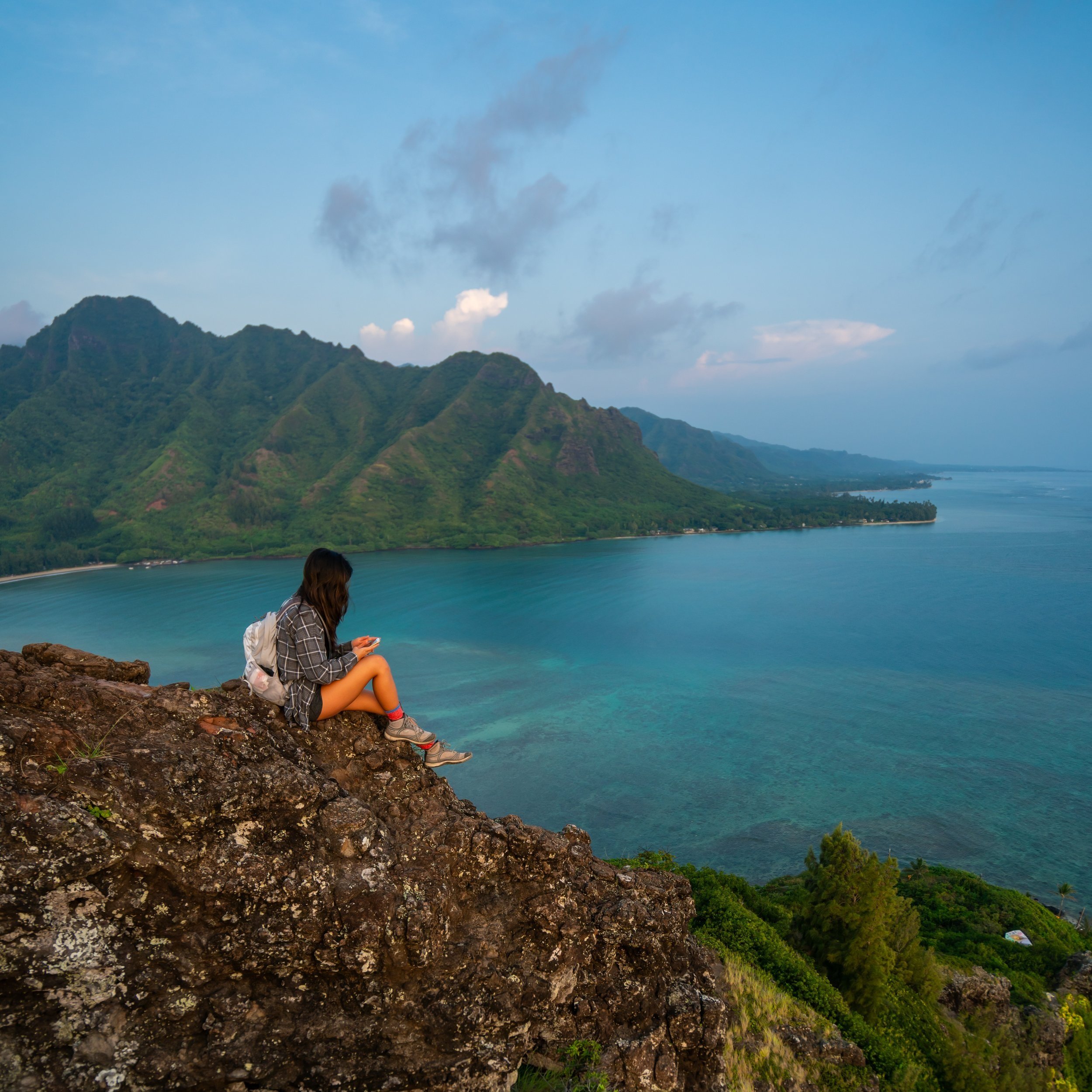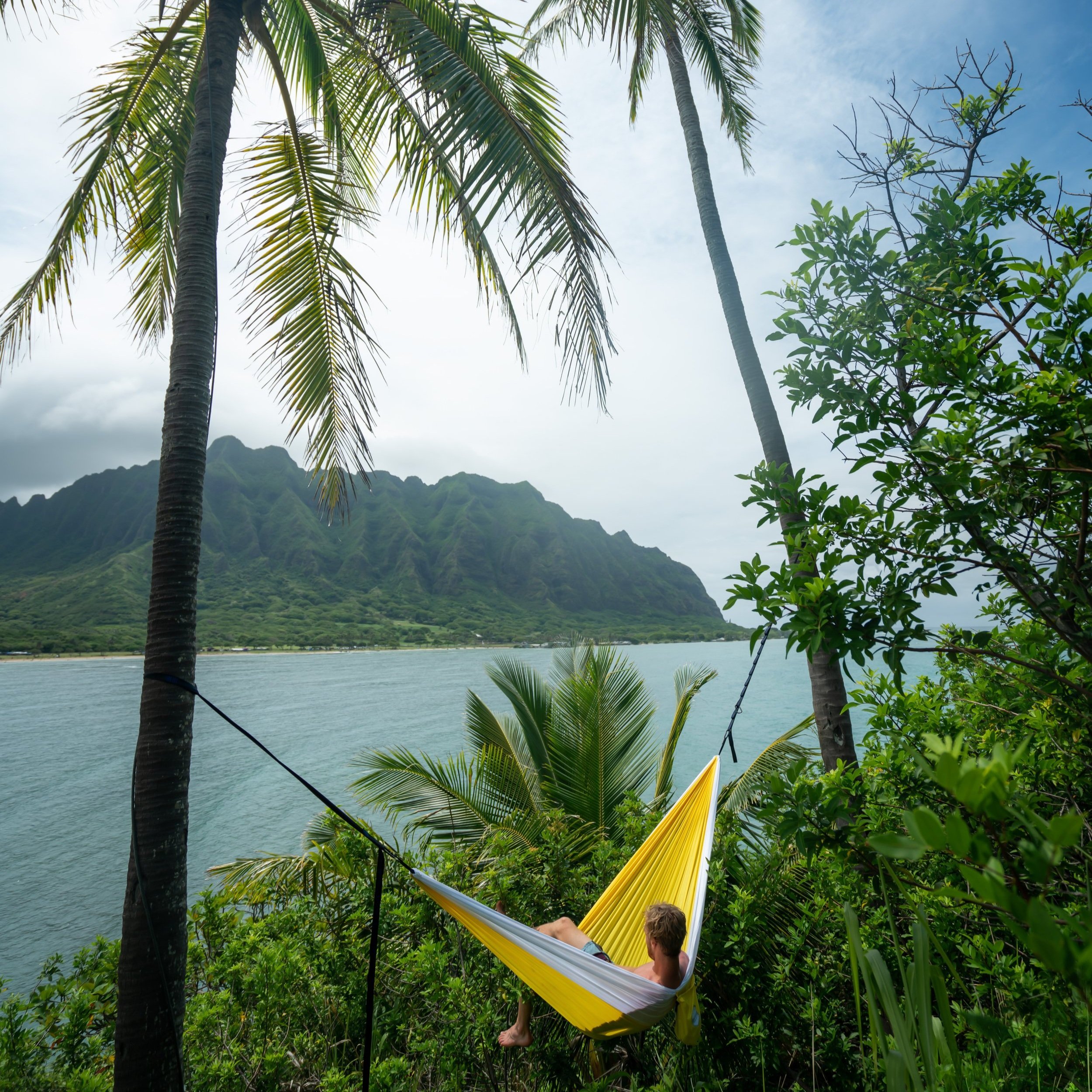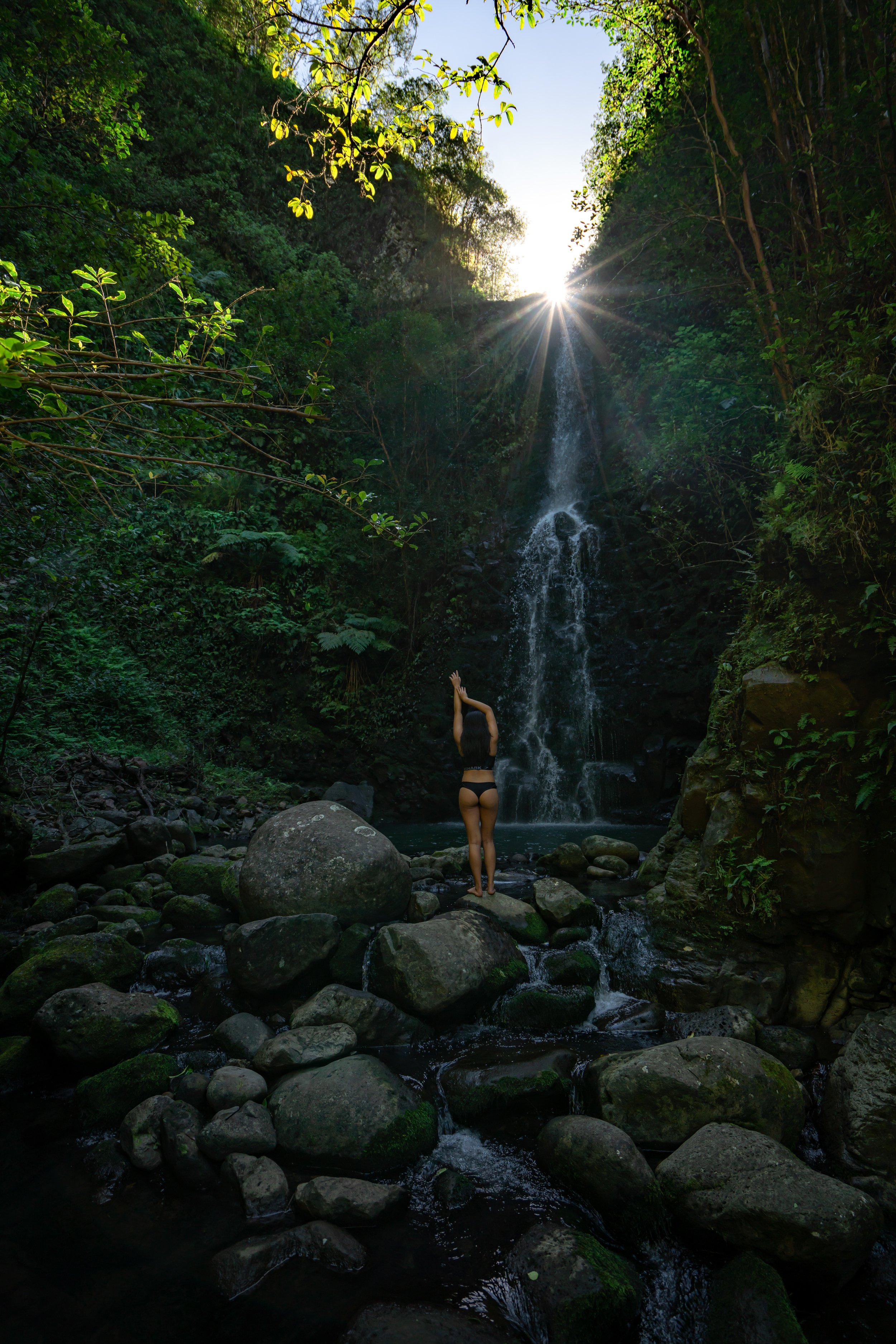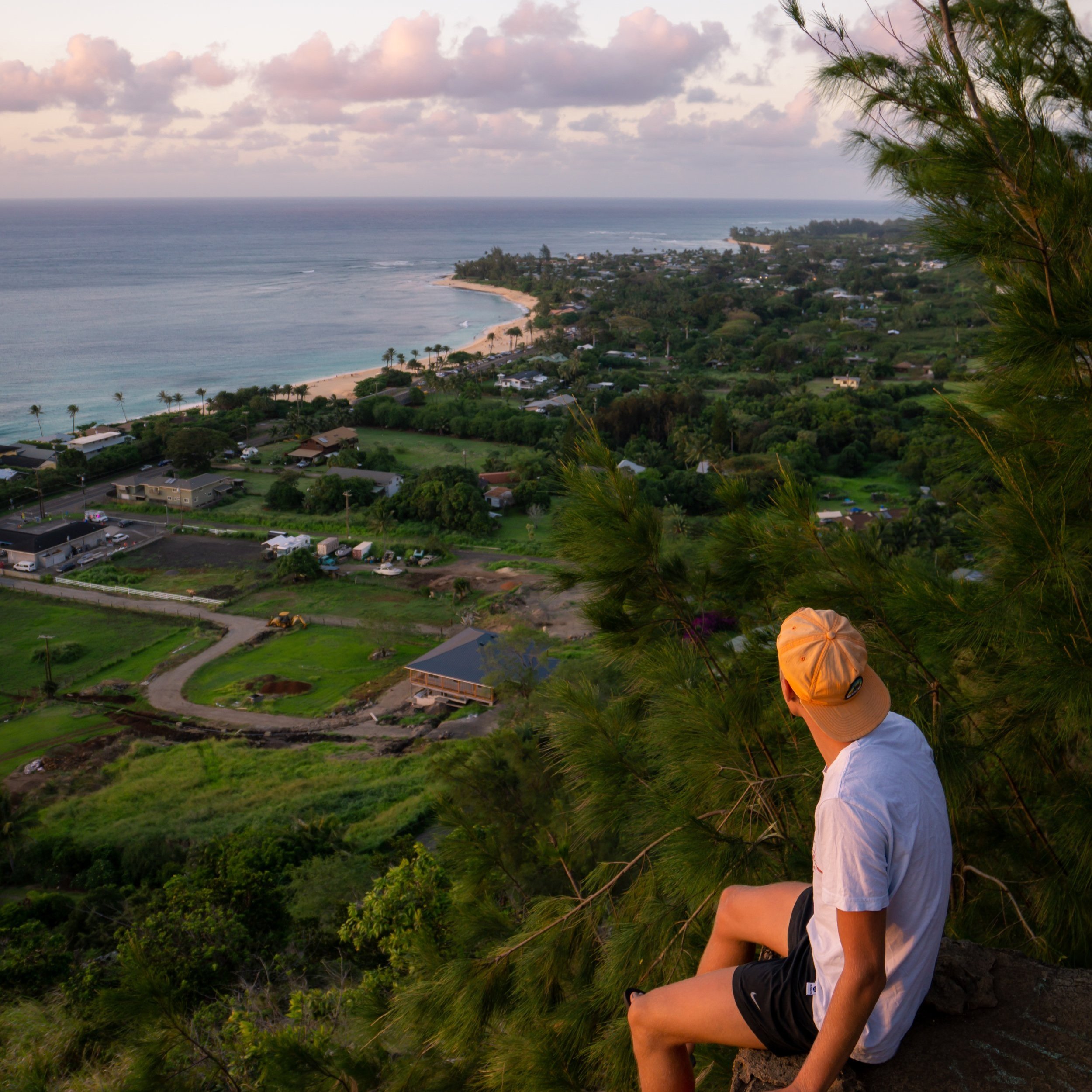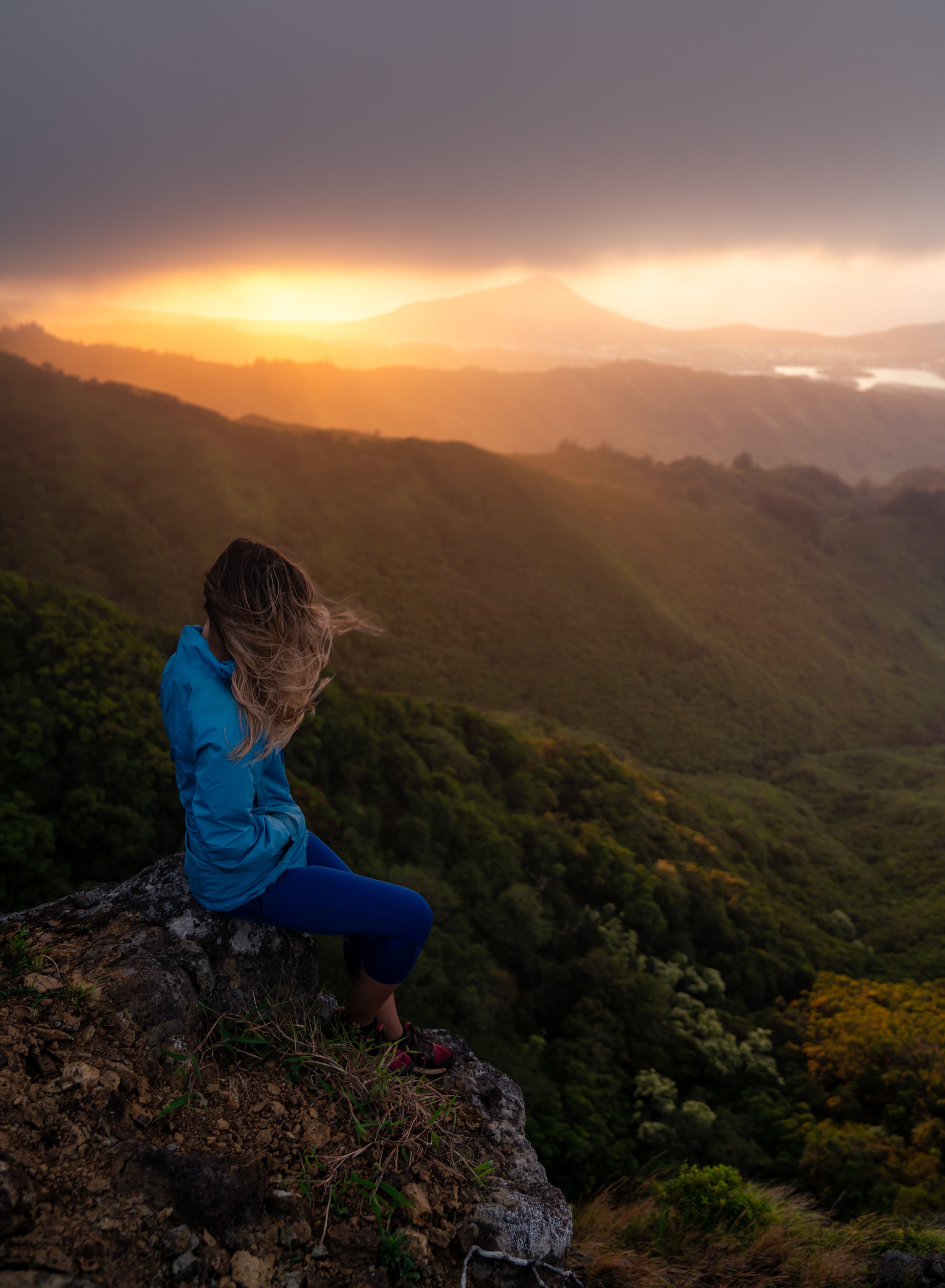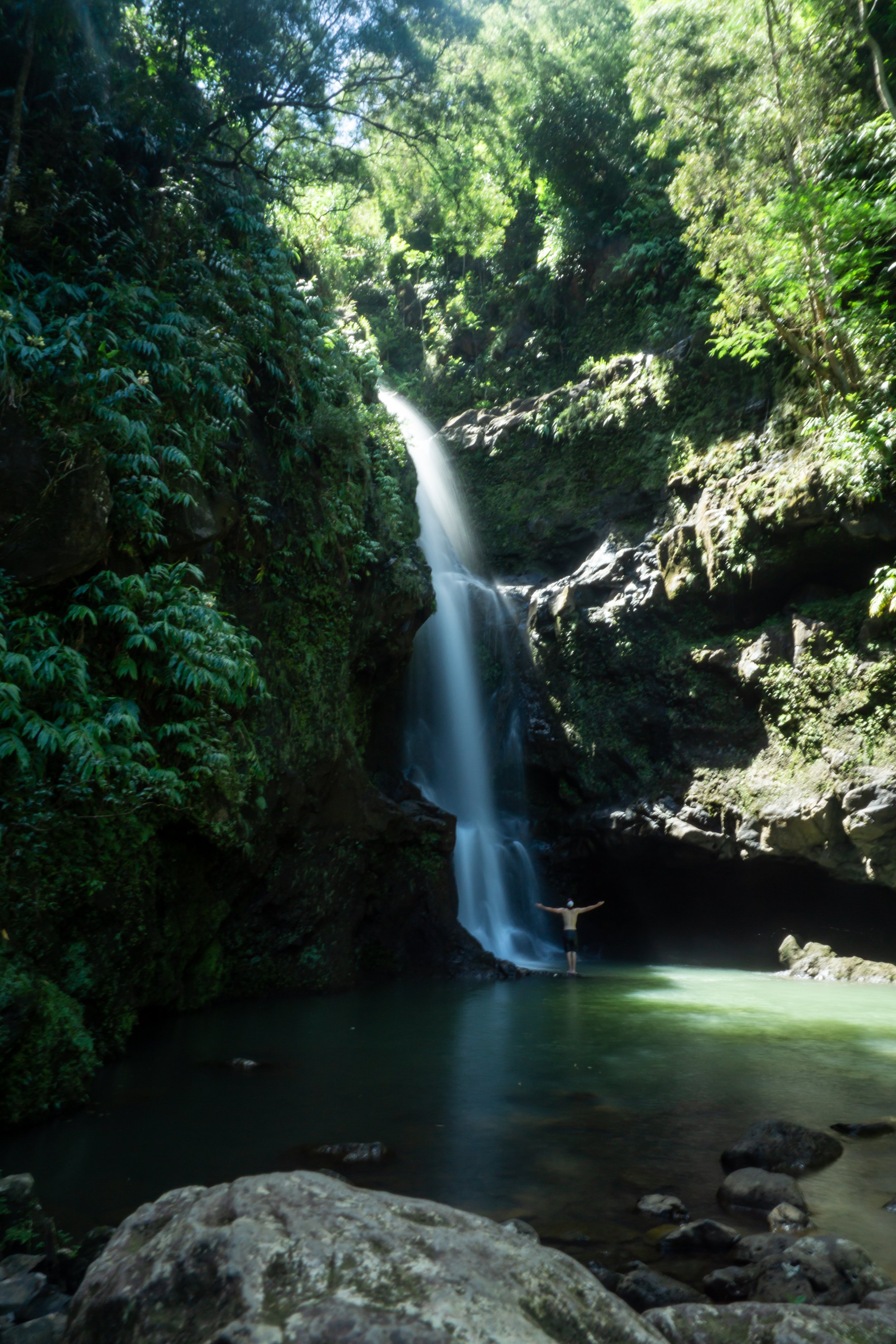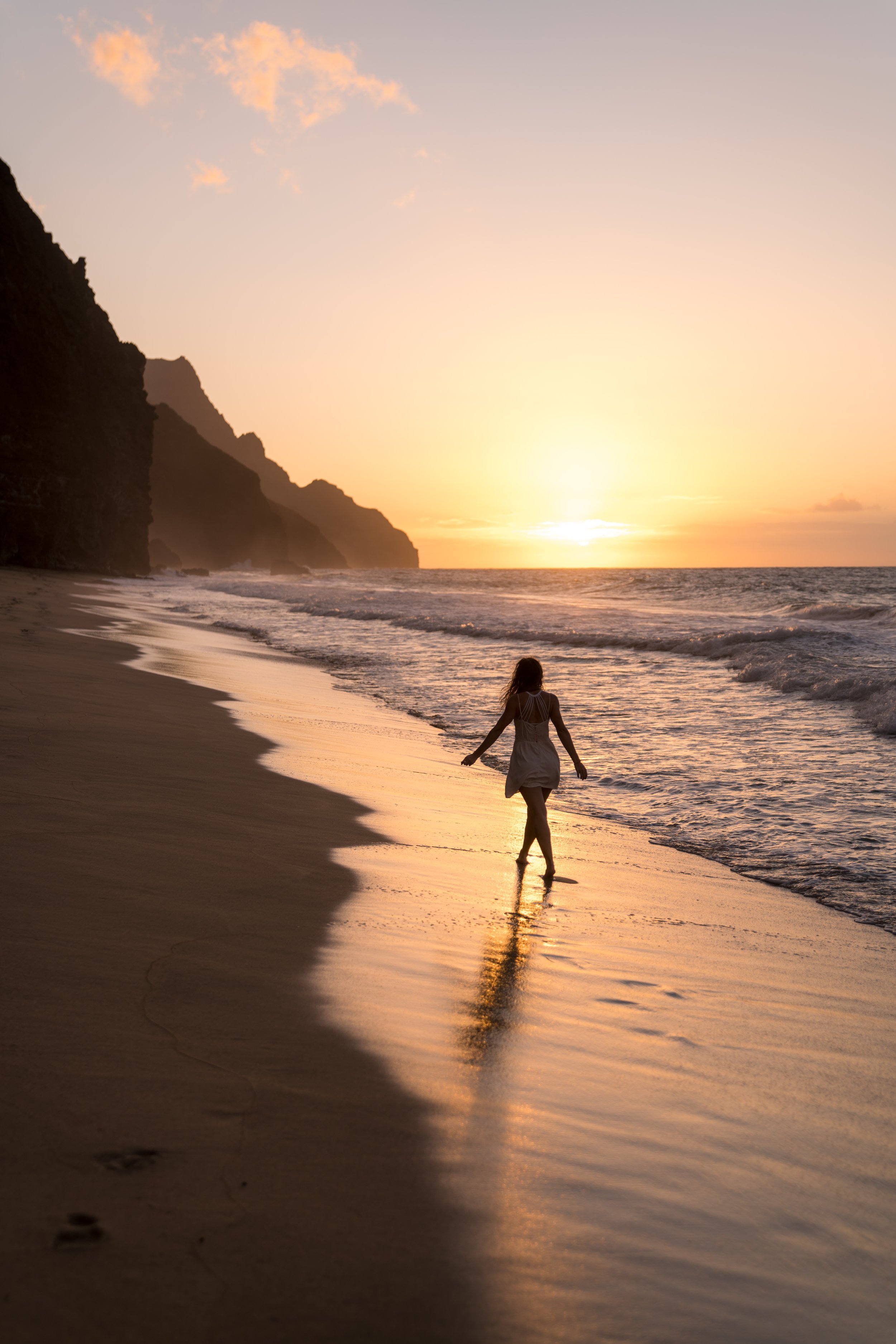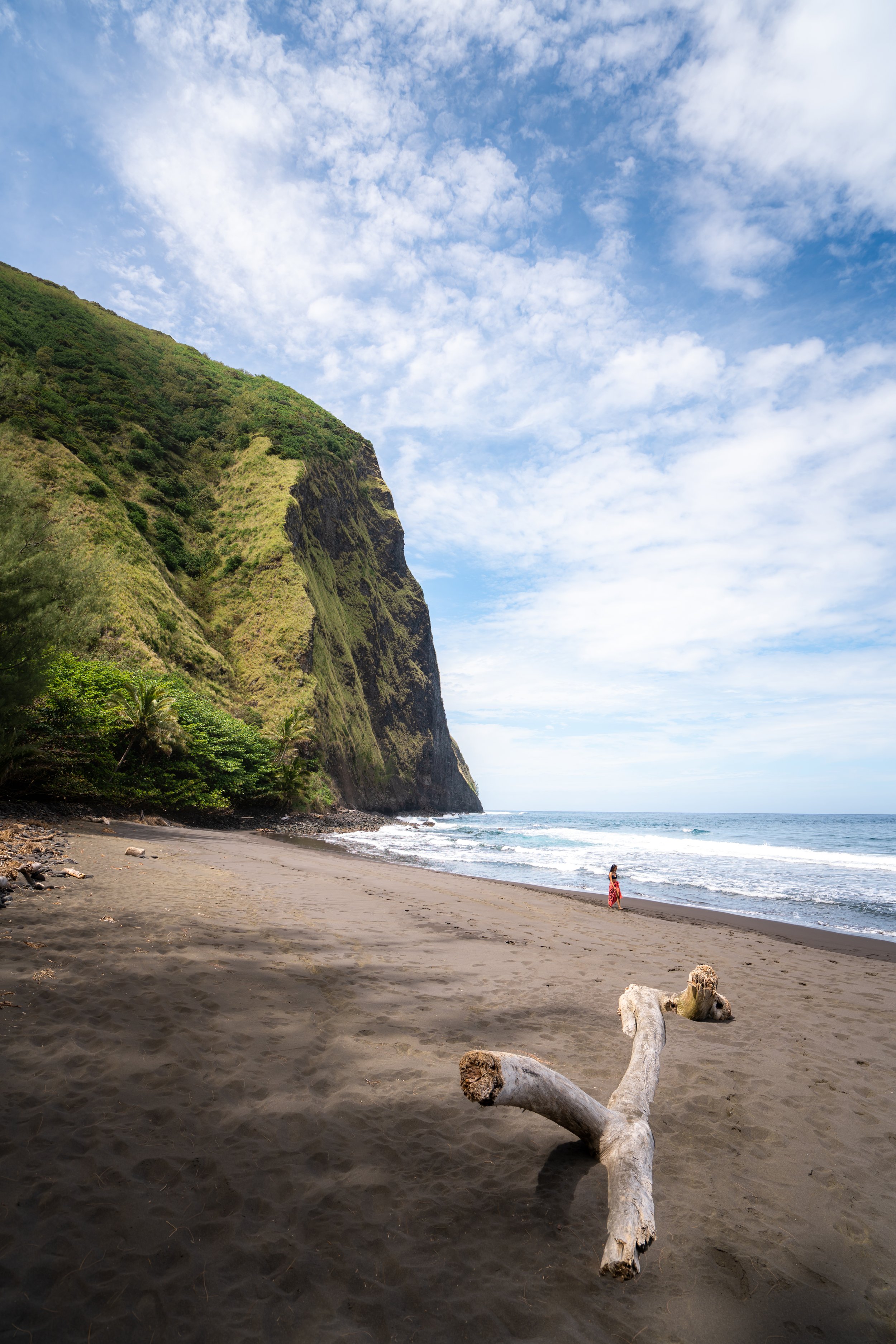Hiking the Kuliʻouʻou Ridge Trail on Oʻahu, Hawaiʻi
Distance: 4.7 miles / 7.6 km
Elevation Gain: ~1,650 ft. / 503 m
The Kuliʻouʻou Ridge Trail in the southeastern Koʻolaus on Oʻahu is the best of the best when it comes to hiking on the island!
By this, I mean that Kuliʻouʻou Ridge is, without a doubt, one of the best sunrise hikes on Oʻahu, the summit is one of the most scenic viewpoints on the island, and Kuliʻouʻou is one of the 'easier,' more accessible day hikes—given that the difficulty of reaching similar viewpoints on Oʻahu only increases from here.
This is all to say that the Kuliʻouʻou Ridge Trail is one of my favorite hikes on Oʻahu, and I recommend hiking it early in the morning over any other time of the day, primarily because of the way the sun rises and the fact that parking is easiest early in the day.
Kuliʻouʻou Ridge Trailhead Parking
Parking for both the Kuliʻouʻou Ridge Trail and the Puʻu ʻO Kona Trail are located at the same trailhead in the back of Kuliʻouʻou Valley on Kālaʻau Place, about 20-25 minutes away from Waikīkī.
That said, parking on Kālaʻau Place has very limited space for both residents’ cars, as well as hikers all fighting for the same spots. Therefore, parking is one of the biggest reasons that I recommend starting early—especially on weekends!
Google Maps Directions: Kuliʻouʻou Ridge Trailhead
My Hawaiʻi Hiking Checklist
Osprey 3L Water Bladder - The Osprey 3L water bladder is the most universal hiking and backpacking water bladder on the market, and it’s my go-to because of the slide-off seal that allows it to be quickly filled from the top. Additionally, individual parts are easily replaceable, such as the bite valve.
Blister / Heel Protectors - I swear by these cheap, amazing heel protectors to prevent blisters for nearly every kind of hiking and backpacking that I do!
Black Diamond Headlamp - Personally, I recommend the Black Diamond Storm because it is one of the brightest, lightest, and longest-lasting headlamps on the market—and trust me, the weight-to-battery-life ratio really does matter!
Hiking / Trail Running Shoes - Depending on the type of trail, I prefer to use either the Keen Targhee for longer, more rugged hiking or the HOKA Zinal Trail-Running Shoe for lighter, less intense trails. In either case, both have been amazing to me for many years across countless environments, and both can be found in men’s and women’s sizes. - (Men’s Keen / Women’s Keen) (Men’s HOKA / Women’s HOKA)
Waterproof Rain Shell - You never know when it may rain, and I’ve learned over the years that a rain shell is far better than a rain jacket. By this, I mean that it’s best to have something that the water will roll right off of, which is why I recommend the Patagonia Torrentshell 3L available in both men’s and women’s sizes.
High SPF Sunscreen - Packing high-SPF sunscreen is a must for long days outside!
Hiking the Kuliʻouʻou Ridge Trail
The Kuliʻouʻou Ridge Trail begins at the very end of Kālaʻau Place, following a service road for the first 0.1 miles (0.2 km) to the true trailhead on the right-hand side.
Kuliʻouʻou-Puʻu ʻO Kona Junction
After a short distance, go right to leave the service road and begin the Kuliʻouʻou Ridge/ Valley Trail, which will follow the same path for the first 0.25 miles (0.4 km).
On a different note, the service road that continues to the left is the route for the Puʻu ʻO Kona Trail, which can be connected by way of the Koʻolau Summit Trail (KST) once at the top. This is where the name Kuliʻouʻou Loop Trail comes from.
Read My Separate Post: Puʻu ʻO Kona Trail
Kuliʻouʻou Ridge-Kuliʻouʻou Valley Junction
After 0.25 miles (0.4 km), the Kuliʻouʻou Ridge Trail splits with the Kuliʻouʻou Valley Trail.
Essentially, the Kuliʻouʻou Valley Trail is a short 0.5-mile (0.8 km) one-way trail that leads up the bottom of Kuliʻouʻou Valley, but to continue up to Kuliʻouʻou Ridge, turn right at this split to begin the switchbacks.
Read My Separate Post: Kuliʻouʻou Valley Trail
In total, there will be 12 or 13 switchbacks, depending on how you count, to climb out of Kuliʻouʻou Valley and gain the ridge.
That being said, these switchbacks are not nearly as steep as other hikes on Oʻahu, such as the nearby Koko Crater Stairs or the summit push up Wiliwilinui Ridge.
In fact, Kuliʻouʻou Ridge can make for a great, but challenging, trail run, which I have personally done many times.
Kuliʻouʻou Ridge
When the trail finally levels out, you will have reached the crest of Kuliʻouʻou Ridge, which will remain on the ridge for the rest of the hike to the summit.
That being said, pay close attention to this area in the photos below, as hikers have gotten lost here in the past by missing this turn down the ridge. I’ll talk more about this later.
Kuliʻouʻou Shelter
After the Kuliouʻou Shelter, the Kuliʻouʻou Ridge Trail starts to get a lot steeper, which will be the case for much of the remaining hike to the Koʻolau Summit.
After the bench, the Kuliʻouʻou Ridge Trail enters the most native-forested section on the entire trail.
That being said, this final stretch to the summit tends to be the muddiest part of the trail, regardless of whether it has rained recently or not.
Then, just prior to the summit, Kuliʻouʻou Ridge climbs numerous sets of stairs that tend to be the most cardio-intensive parts of the entire hike.
Kuliʻouʻou Summit
Once you climb up the final stairs, you will reach the panoramic Kuliʻouʻou Summit that looks out over Oʻahu’s east side!
To the north (left), you can see notable places like Mt. Olomana and even as far as Mokoliʻi on a clear day, and to the south/ east (right), you can see great views of Koko Crater, the Hanauma Bay Rim, and out toward Makapuʻu Point.
Furthermore, you may even be able to see as far as Molokai and Maui to the east on the clearest of days!
That being said, it’s important to mention that on very rainy/ cloudy days, there may not be a view at the top, as the summit often gets socked in by low-hanging clouds brought in with the trade winds.
Therefore, it’s important to remember that just because it’s not raining in Honolulu/ Waikīkī doesn’t mean it’s not raining in the mountains nearby. For this reason, I recommend checking the weather forecasts in Waimānalo and East Honolulu to have the best idea if the weather will be nice when you plan to hike.
Koʻolau Summit Trail (KST)
On a different note, this large exposed section on the ridge is actually a small portion of a much longer cross-island hike, known as the Koʻolau Summit Trail (KST).
That being said, I highly recommend against hiking past Kuliʻouʻou Summit if you hadn’t prepared for anything longer, as any section of Koʻolau Summit is much harder, more involved, and more intense than anything experienced on Kuliʻouʻou Ridge.
Read My Separate Post: Koʻolau Summit Trail (KST)
Hiking Down Kuliʻouʻou Ridge
For the most part, the return hike is nothing more than retracing your steps.
However, pay close attention to the right turn heading off the ridge in the photo below.
As previously mentioned, hikers in the past have gotten lost here by accidentally going straight toward Hahaʻione/ Pyramid Rock, instead of turning right toward Kuliʻouʻou Valley.
Native Plants on Kuliʻouʻou Ridge
When compared to other hikes on Oʻahu, Kuliʻouʻou is a fairly low-elevation trail, meaning that even in its most native upper portion, it’s still inundated with invasive species like Octopus Trees and Shoebutton—a reminder of the impacts that humans have.
However, there are still a number of native plants that you can find on the Kuliʻouʻou Ridge Trail, such as ʻŪlei, ʻIlieʻe, Lonomea, Alaheʻe, and Wiliwili in the lower elevations.
Then, once the trail breaks out of the canopy, Kuliʻouʻou Ridge enters the most native section of the trail. Here, you will be able to find ʻŌhiʻa lehua, ʻIeʻie, and a few Lama trees on the left-hand side heading up the stairs.
If you are interested in learning more about these and other native Hawaiian plants from across the islands, check out my separate article that I wrote entirely about native plants in Hawaiʻi.
Read My Separate Post: Native Hawaiian Plant Guide
More Oʻahu Adventures
If you’re interested in reading about some more amazing Oʻahu adventures, check out my separate posts below!
Best Hotels & Restaurants in Waikīkī
If you’re trying to decided where to stay on Oʻahu, check out my top 10 list for the best resorts and restaurants in Waikīkī.
I break down what makes one hotel a better choice over another, so that you can find the best fit for your stay on the island.
Read My Separate Post: Best Waikīkī Hotels & Restaurants
HNL Airport-Hotel Shuttle
Prices on ride-share apps like Uber/ Lyft cannot beat the price of booking your hotel shuttle prior to arrival. I say this because there are additional fees for ride-share airport pick-ups at Honolulu Airport (HNL), which is why I recommend booking your transportation in advance using the options below.
Additionally, the last option below will go as far as the Ko ʻOlina Resorts on the West Side and Turtle Bay on Oʻahu’s North Shore!
Best Way to Book Rental Cars!
I travel quite a bit, and I know firsthand that finding a good rental car deal can be a challenge, but that’s why I recommend comparing all of your options with Discover Cars.
In short, Discover Cars is a well-known, reputable business that allows you to search for the best deal across companies, and they have the best full-refund cancellation policy I’ve ever seen, valid up to 72, or sometimes even 48, hours prior to your reservation!
Book Here: Discover Cars
Visiting Other Islands
If you are visiting Oʻahu or heading to another island, check out some of my personal recommendations for Oʻahu, Maui, Kauaʻi, Molokai, Lānaʻi, and Hawaiʻi Island (Big Island) in these separate posts.
If you’re trying to decide which island is right for your visit, check out my overview about each island in the post below.
Read My Separate Post: What is the Best Hawaiian Island to Visit?
What is the Best Time of Year to Visit Hawaiʻi?
The weather in Hawaiʻi can often appear to be warm and beautiful throughout the year, but in my experience, there is a lot more to consider when planning what time of year to visit the islands, such as what island you are considering, what sides of each island do you plan to stay, what activities are you most interested in, the wildlife, and countless other nuanced variables that can all impact the type of trip you can expect to have.
For these reasons, I highly recommend reading through my separate article to not only understand my thoughts regarding the best time of year to come to Hawaiʻi but also what you need to consider based on the time of year that you plan to visit.
Read My Separate Post: What is the Best Time of Year to Visit Hawaiʻi?
10 Best Tours & Excursions on Oʻahu
There are a lot of different tour options to choose from on Oʻahu, but to make it easier to decide, I made a list of my favorite tours because some things simply are better with a local guide!
Read My Separate Post: Best Tours on Oʻahu
Safety
All hikes in Hawaiʻi should not be compared to trails outside of the islands, and hikers should exercise due caution on every adventure, given that many are extremely dangerous.
By this, I mean that Hawaiʻi is known for hot, humid weather, steep, dramatic, and unstable cliffs, and flash floods, which can occur without warning. Therefore, it is important that you check the local forecast, understand the physical condition of your entire group, and pack sufficient food and water before attempting any adventure.
Disclaimer
All information provided on this blog is for informational purposes only and is not intended to be a substitute for information or advice from qualified professionals or managing agencies.
Noah Lang Photography LLC makes no representations or warranties regarding the accuracy or completeness of the information provided here, and readers should use their own discretion, judgement, and seek professional advice where it is appropriate.
Furthermore, Noah Lang Photography LLC shall not be held responsible for any injuries, lost individuals, or legal issues arising from the use of information provided on this website, and if applicable, the above safety disclaimer should be referenced to provide a generic overview of the risks involved.
All said, the content on this blog is for the sole use of Noah Lang Photography LLC, and unauthorized use or reproduction of this content is strictly prohibited.
Disclosure
This post is not sponsored.
However, some of the links in this post are affiliate links, which means that I may earn a small commission if a purchase is made through one of those links. This commission comes at no additional cost to you, and I only recommend products that I personally use and believe will add value to my readers. Thank you for your support, which enables me to continue creating more!
To read the full privacy policy, click here.

About This Blog
Noah Lang Photography, also known as @noahawaii, is 100% reader-supported!
I do not accept guest articles or sponsored content of any kind on my blog, which is why, if you enjoy the outdoor and travel content I create, please consider buying me a coffee!
I appreciate your support, which helps me continue to keep this blog alive!










